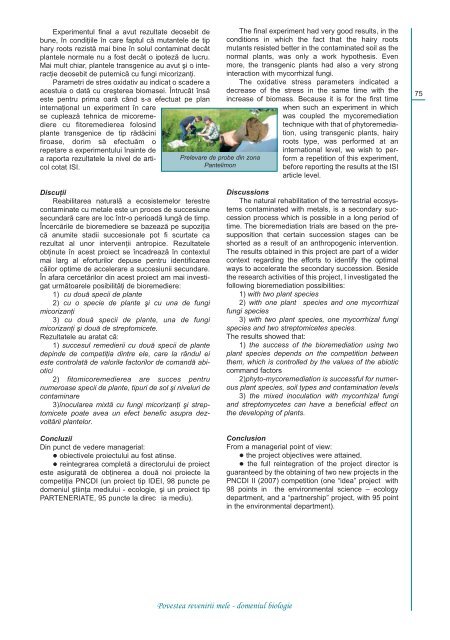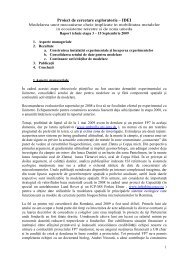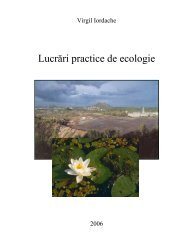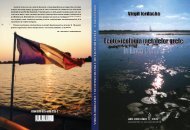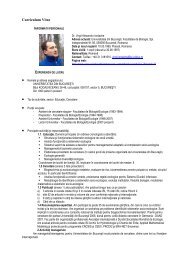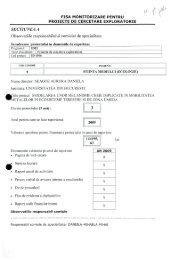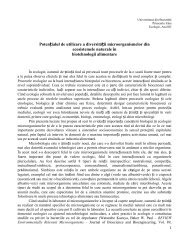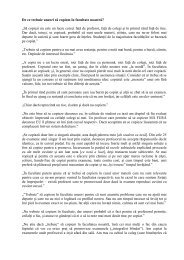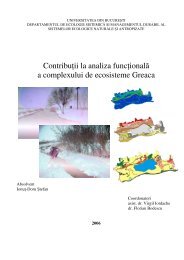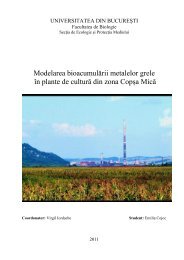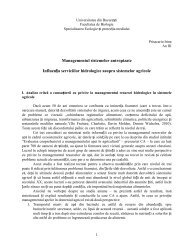Povestea revenirii mele - uefiscdi
Povestea revenirii mele - uefiscdi
Povestea revenirii mele - uefiscdi
Create successful ePaper yourself
Turn your PDF publications into a flip-book with our unique Google optimized e-Paper software.
Experimentul final a avut rezultate deosebit de<br />
bune, în condiţiile în care faptul că mutantele de tip<br />
hary roots rezistă mai bine în solul contaminat decât<br />
plantele normale nu a fost decât o ipoteză de lucru.<br />
Mai mult chiar, plantele transgenice au avut şi o interacţie<br />
deosebit de puternică cu fungi micorizanţi.<br />
Parametri de stres oxidativ au indicat o scadere a<br />
acestuia o dată cu creşterea biomasei. Întrucât însă<br />
este pentru prima oară când s-a efectuat pe plan<br />
internaţional un experiment în care<br />
se cuplează tehnica de micoremediere<br />
cu fitoremedierea folosind<br />
plante transgenice de tip rădăcini<br />
firoase, dorim să efectuăm o<br />
repetare a experimentului înainte de<br />
a raporta rezultatele la nivel de articol<br />
cotat ISI.<br />
Prelevare de probe din zona<br />
Pantelimon<br />
The final experiment had very good results, in the<br />
conditions in which the fact that the hairy roots<br />
mutants resisted better in the contaminated soil as the<br />
normal plants, was only a work hypothesis. Even<br />
more, the transgenic plants had also a very strong<br />
interaction with mycorrhizal fungi.<br />
The oxidative stress parameters indicated a<br />
decrease of the stress in the same time with the<br />
increase of biomass. Because it is for the first time<br />
when such an experiment in which<br />
was coupled the mycoremediation<br />
technique with that of phytoremediation,<br />
using transgenic plants, hairy<br />
roots type, was performed at an<br />
international level, we wish to perform<br />
a repetition of this experiment,<br />
before reporting the results at the ISI<br />
article level.<br />
75<br />
Discuţii<br />
Reabilitarea naturală a ecosistemelor terestre<br />
contaminate cu metale este un proces de succesiune<br />
secundară care are loc într-o perioadă lungă de timp.<br />
Încercările de bioremediere se bazează pe supoziţia<br />
că anumite stadii succesionale pot fi scurtate ca<br />
rezultat al unor intervenţii antropice. Rezultatele<br />
obţinute în acest proiect se încadrează în contextul<br />
mai larg al eforturilor depuse pentru identificarea<br />
căilor optime de accelerare a succesiunii secundare.<br />
În afara cercetărilor din acest proiect am mai investigat<br />
următoarele posibilităţi de bioremediere:<br />
1) cu două specii de plante<br />
2) cu o specie de plante şi cu una de fungi<br />
micorizanţi<br />
3) cu două specii de plante, una de fungi<br />
micorizanţi şi două de streptomicete.<br />
Rezultatele au aratat că:<br />
1) succesul remedierii cu două specii de plante<br />
depinde de competiţia dintre ele, care la rândul ei<br />
este controlată de valorile factorilor de comandă abiotici<br />
2) fitomicoremedierea are succes pentru<br />
numeroase specii de plante, tipuri de sol şi niveluri de<br />
contaminare<br />
3)înocularea mixtă cu fungi micorizanţi şi streptomicete<br />
poate avea un efect benefic asupra dezvoltării<br />
plantelor.<br />
Concluzii<br />
Din punct de vedere managerial:<br />
obiectivele proiectului au fost atinse.<br />
reintegrarea completă a directorului de proiect<br />
este asigurată de obţinerea a două noi proiecte la<br />
competiţia PNCDI (un proiect tip IDEI, 98 puncte pe<br />
domeniul ştiinţa mediului - ecologie, şi un proiect tip<br />
PARTENERIATE, 95 puncte la direc ia mediu).<br />
Discussions<br />
The natural rehabilitation of the terrestrial ecosystems<br />
contaminated with metals, is a secondary succession<br />
process which is possible in a long period of<br />
time. The bioremediation trials are based on the presupposition<br />
that certain succession stages can be<br />
shorted as a result of an anthropogenic intervention.<br />
The results obtained in this project are part of a wider<br />
context regarding the efforts to identify the optimal<br />
ways to accelerate the secondary succession. Beside<br />
the research activities of this project, I investigated the<br />
following bioremediation possibilities:<br />
1) with two plant species<br />
2) with one plant species and one mycorrhizal<br />
fungi species<br />
3) with two plant species, one mycorrhizal fungi<br />
species and two streptomicetes species.<br />
The results showed that:<br />
1) the success of the bioremediation using two<br />
plant species depends on the competition between<br />
them, which is controlled by the values of the abiotic<br />
command factors<br />
2)phyto-mycoremediation is successful for numerous<br />
plant species, soil types and contamination levels<br />
3) the mixed inoculation with mycorrhizal fungi<br />
and streptomycetes can have a beneficial effect on<br />
the developing of plants.<br />
Conclusion<br />
From a managerial point of view:<br />
the project objectives were attained.<br />
the full reintegration of the project director is<br />
guaranteed by the obtaining of two new projects in the<br />
PNCDI II (2007) competition (one “idea” project with<br />
98 points in the environmental science – ecology<br />
department, and a “partnership” project, with 95 point<br />
in the environmental department).<br />
<strong>Povestea</strong> <strong>revenirii</strong> <strong>mele</strong> - domeniul biologie


